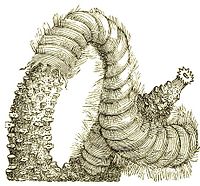Doctor Bronson answered that it varied greatly, the inner lagoon being sometimes only a few feet, or perhaps inches, in depth, and sometimes two, three, or five hundred feet. Outside there is generally a great depth of water, sometimes so much that the sounding-lead fails 
THE CORAL WORM.to find bottom at a distance of only a few yards. "This constitutes," he added, "one of the dangers of navigation, as a ship may be close upon a reef without being aware of it until too late.
"The coral insect," he continued, "does not work at a greater depth than two hundred feet, and he ceases operations when he reaches the surface. When these reefs are more than two hundred feet deep it is supposed that the bottom has slowly receded and carried the reef with it; as the recession went on, the coral insect continued his work of building. It reminds me of what happens sometimes to a railway in a swampy region; the embankment for the track sinks from time to time, and a new one is built above it. After a while sufficient earth has been thrown in to make a solid foundation, and then the sinking ceases.
"The atoll is another curious form of the work of the coral insect," said the Doctor, continuing. "It is circular or oval in shape, the island forming a rim that encloses a lake or lagoon. There is always an opening from the sea to the lagoon, and it is generally on the leeward side. Sometimes there are two, or even three or more openings, but this is unusual; the island rises only a few feet above the water, and is the work of the coral insect upon what was once the crater of a volcano; at least that is the general belief.
"The atoll is not a desirable place for residence, as the ocean during severe storms is liable to break across the narrow strip of land and sweep away whatever may be standing there. Many atolls are uninhabited, and none of them has a large population; cocoa-palms, bread-fruit, and other tropical trees are generally found on the inhabited atolls, and partially or wholly supply the natives with food. In some instances the people support themselves by fishing either in the lagoon or in the ocean outside. The lagoon forms a fairly good harbor for
